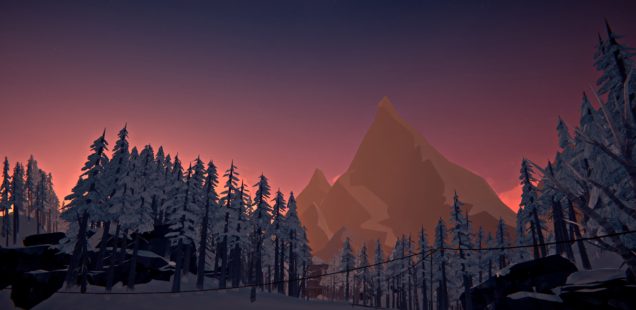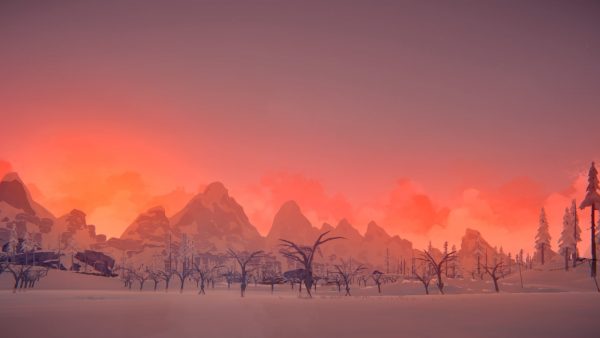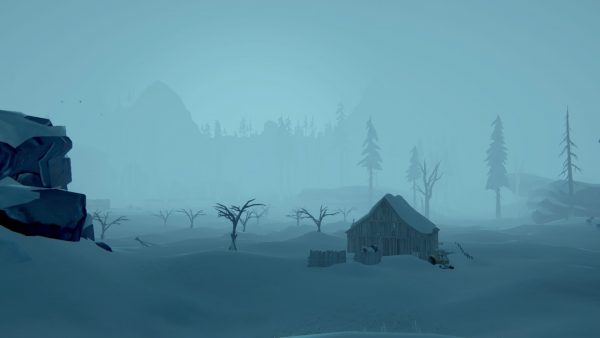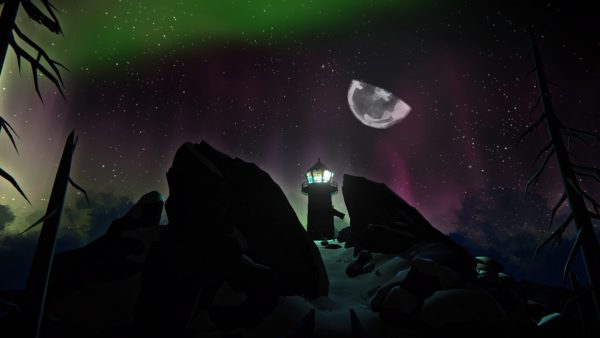
To Feel Small and Know Your Worth: The Long Dark’s Vision of Survival
Wyeth Leslie has miles to go before he sleeps.
“Life is an error-making and an error-correcting process, and nature in marking man’s papers will grade him for wisdom as measured both by survival and by the quality of life of those who survive.” – Jonas Salk
Set in Northern Canada during the depths of winter, Hinterland Games’ The Long Dark puts players into the shoes of a survivor stranded on Great Bear Island, located just beyond the reach of the mainland. The apocalypse has come to this lonely corner of the world, some mysterious global disaster rendering all electrical machines useless, but it hardly matters. People have been largely absent from Great Bear Island long before the grid went down. The game has several modes (Survival, the excellent episodic narrative Wintermute, Challenge Modes, and the occasional seasonal timed activity), all taking place across the many regions of the island. In Survival, there are no objectives, no text popping up on screen to tell you what to do, where to go, or even what you need. Players can determine their survivor’s gender but, in the end, this makes no difference. Death is the great equalizer and it’s at the core of The Long Dark’s gameplay. It will follow you across the land and there may be miles and wolves between you and someplace warm. This is the beauty and the point of The Long Dark’s survival fantasy, that you never feel greater than your environment or more powerful than your human limitations.
One of the great joys of video games is how they allow players to achieve an out-of-the-ordinary sense of accomplishments. Few things are as satisfying as finally taking down Elden Ring’s Malenia or pulling off a win in Apex Legends. In the same vein, The Long Dark is certainly not lacking in difficulties to overcome. The game will throw challenges at you any chance it gets, and you can look no further than the territorial predators that inhabit the island. Making it through these obstacles can feel just as rewarding, especially when it’s through sheer luck. The severity of such encounters, as with the overall experience, are affected by what difficulty you pick. Easier difficulties have the same feeling as a nice hike along your favorite park trail. On harder difficulties, your grasp on existence becomes much more tenuous. The toughest setting is titled “Interloper” and players must be both exceptionally skilled and lucky just to survive the first night. But even at lower difficulties, The Long Dark’s ideology is still intact. You, the player, are not permanent and nature is still to be respected.

I am not a hardcore Long Dark player by any means. I do not know any of the meta strategies and I have no desire to learn. As a way of further immersing myself in the game, I like the idea that my survivor would act as I would in such a situation, adapting on the fly. Having lived with long summers and mild winters all my life, the harsh realities of The Long Dark are beyond my comprehension. But there are still some relatable struggles. As someone with weak ankles, every time I roll one in-game while trying to navigate down a steep incline, I very much feel it in my own feet. It’s a moment of relatable struggle as I’m forced to consider my own fragility and the game is full of such reminders. Because of these, The Long Dark is able to build a power fantasy that makes the act of surviving the actual reward, no matter how you achieve it.
A lot of similar sandbox games lean into ugly visions of survival. There might be enemies which makes the player goal to become the dominant force over the environment. Maybe there are resources to be harvested, turning the land into a space to be stripped for parts. Death is only temporary with respawns or saves to be reloaded if something goes wrong. I recently played through one such game with a friend and as we progressed, the forest around our base diminished and enemies piled up in our traps. It was an exhausting experience for me, the game’s depiction of survival coming across as both heavy handed and uninspiring. The Long Dark has elements of environmental domination, of hunting and harvesting resources, but uses them as means to a different goal. Wolves, bears, and moose (never underestimate the moose) are all ready to chew or stomp on your harried survivor but they are just part of the ecosystem; it’s nothing personal. You are an intruder in their home after all.
As for resources, entropy comes for everything, making them all the more precious, and just searching for resources accelerates this process. Cut up a log for firewood and it might be some time before it’s replaced, if ever, so then you’ll have to search further away from shelter. Other resources that you find might not be usable to begin with as almost everything in the game has a condition percentage that degrades over time. Eat old or undercooked food and you risk food poisoning and parasites. Try to shoot a rifle in poor condition and it might jam as a wolf lunges at you. Players themselves are linked to this entropy as your player will grow tired, cold, and hungry and these needs must be met. Outside the story mode, there are no manual saves, and the game even autosaves during each failed animal encounter. Upon death, that’s it—there’s no digitally rewinding time to correct your mistake. You can only hope that you gleaned the correct lesson for your next Long Dark life. A player must learn to navigate, if not outright prevent these dangers while balancing the currencies for everything in the game: time and energy.

Like in real life, you only have a certain amount of daylight each day. What you want to and will accomplish are two different things. Not all days are struggles in The Long Dark but this is far from the norm. An average in-game day more often looks like waking up hungry so you go hunting. Maybe you managed to shoot a deer but it didn’t go down so you started to follow the blood trail only for snow to begin falling as the sky clouds over. Do you press on to find the deer in hopes that it bled out nearby and that the snow doesn’t upgrade into a full blizzard, or do you return home hungrier than you were? What if it does turn into a blizzard, the kind that lasts several days? How will you feed yourself then? The answers to all these questions tie into time and energy. If you feel confident, you might press on. Your stamina meter might be full but it might be getting late in the day and the nights on Great Bear Island are dark and full of frostbite and predators. Maybe you just climbed a rope, one of the most strenuous activities in the game, so you might start to hear your character yawning. It’s the formula for all life: every action is energy spent and you only have so much, even on a good day. It’s why knowing where to go and how to get there are the most critical skills in The Long Dark.
There are few things I love more than when a video game makes knowledge of level design instrumental to progress, forcing the player to slow down and appreciate the world that the designers have built for them. Sen’s Fortress in Dark Souls is a perfect example as it shoves your face across the stone floor until you know every inch by heart. What The Long Dark lacks in giant swinging axes, it makes up for in general ambivalence about your existence. Great Bear Island is currently home to twelve main regions . They have been here long before your arrival and they will remain long after your demise, offering little protection beyond a scattering of caves and few and often rundown man-made spaces.
Navigating such spaces even with an intimate knowledge of the map is no easy feat. Twice now I have completed the Faithful Cartographer achievement, one of my favorite video game accomplishments, once on my aging PS4 and more recently on my new desktop computer. This involves mapping every single named location across all regions (Blackrock Penitentiary excluded). Last time I checked, only .2% of PS4 players had managed this feat. On my first successful attempt, I had to acclimate to many different regions that I was unfamiliar with. On the second successful attempt, achieved in roughly half the time, I only had to learn one new region that had been recently added. Knowing the land of Great Bear Island, its snowy forests and abandoned outposts of humanity, is the greatest light you can wield to keep the final night at bay. There are few things more relieving than being able to navigate yourself home in the middle of a blizzard because you recognize an outcropping of rocks that suddenly emerges from the howling white. More useful than any gun or animal fur clothing, familiarizing yourself with the map is the greatest source of empowerment in the game. Unable to shape an entropic world that doesn’t care about you, the only thing that truly lasts in The Long Dark is what you learn.

The Long Dark does have moments of traditional power fantasy. Stopping a bear’s charge with a well-placed rifle shot or making it to the peak of Timberwolf Mountain are breathtaking when achieved, especially as the player has to stare directly and quite literally into the jaws of death. But the most frequent moments of empowerment are quiet. Some might be a day spent in the comfort of indoors with a full larder while you wait for hides to cure. You can make yourself coffee while you read a book, pretending the old world is still intact. Or maybe after days of searching, you finally find the right tool you’ve been needing, hidden under some desk. The Long Dark’s overall sense of success does not come from great accomplishments, but from small victories of momentum, of being able to keep one foot in front of the other and out of the grave. A friend once told me that one of her greatest comforts is listening to a storm rage outside her home while she’s in bed, the wind unable to reach her. I think about this every time I manage to find shelter during a blizzard in The Long Dark. Sometimes, feeling powerful is nothing more than a warm place to sleep.
The Long Dark is a living game. As Hinterland Games continues to build the world of Great Bear Island, each new update feels like a meaningful reinforcement of the game’s thesis on survival. New tools are added with great care not to upset the balance of this world, nothing to make the player overly powerful. The level designers are becoming increasingly crafty with their environments, using surprise one-way routes and landscape optical illusions to play tricks on the player in order to further connection to the game. Even recent additions to the Challenges roster, with names like “As the Dead Sleep,” serve to remind players of the tenuous grasp on existence that the game offers in even the best of times. A bleak power dynamic to be sure, but it’s offset by the beauty of the watercolor aesthetics and its sense of accomplishment. To know that the world does not care about you makes your continued existence its own reward.
A Creative Writing MFA graduate from Oklahoma State University, Wyeth Leslie (he/him) is a poet and author interested in pop culture, humanity, and beauty in the mundane. His writings have been featured in publications such as Drunk Monkeys, Bridge Eight Press, Sledgehammer Lit, The Daily Drunk, and Horror Homeroom. He can usually be found staring into the abyss on Twitter: @Wyeth_was_here.